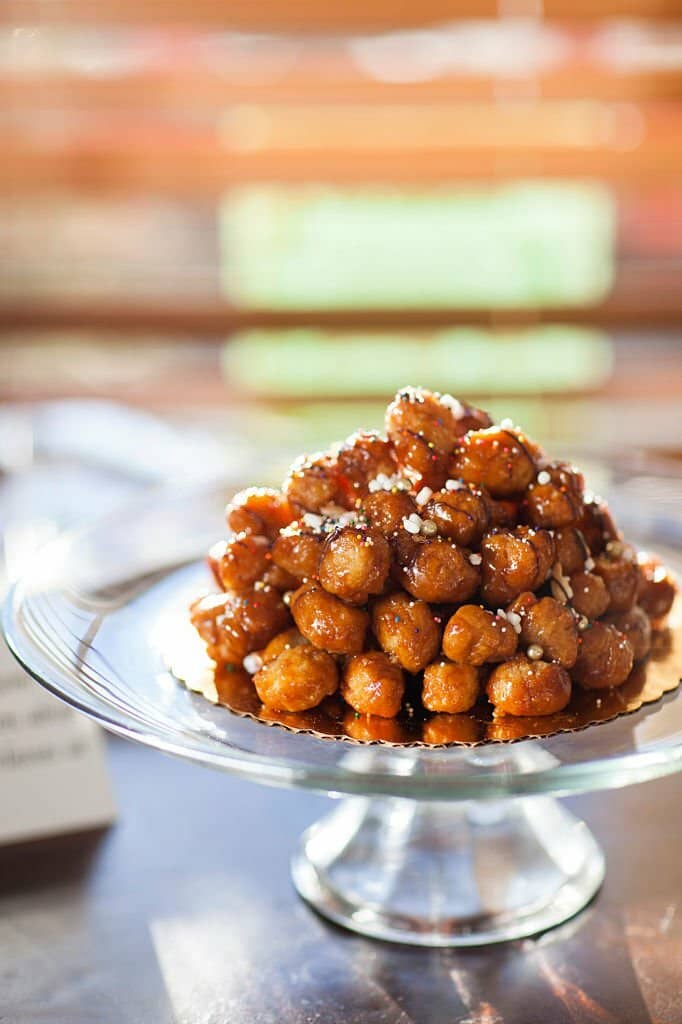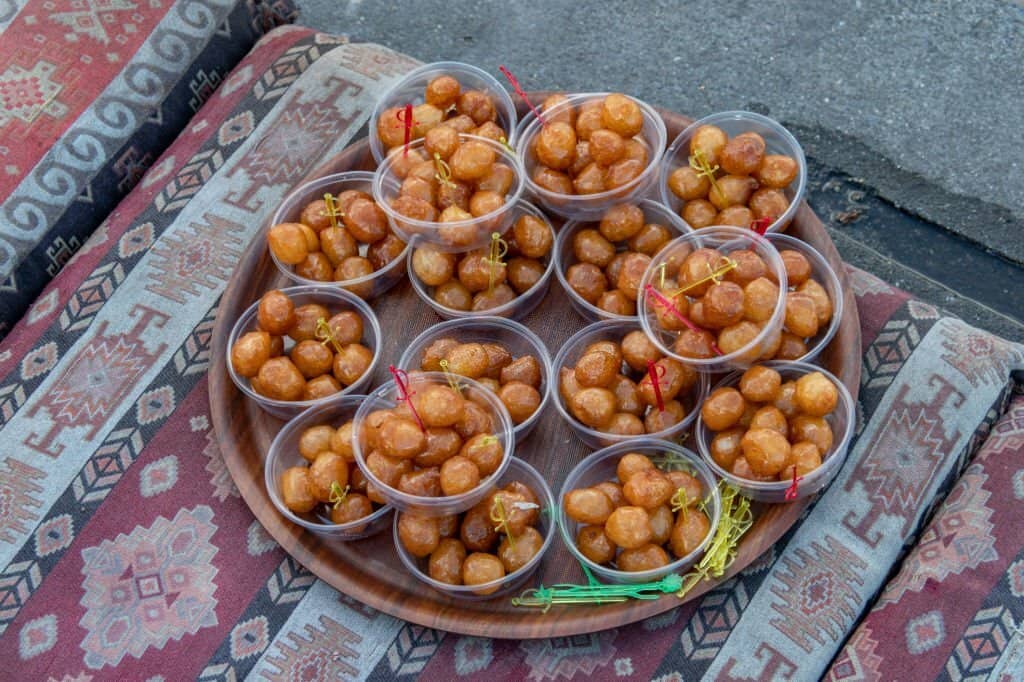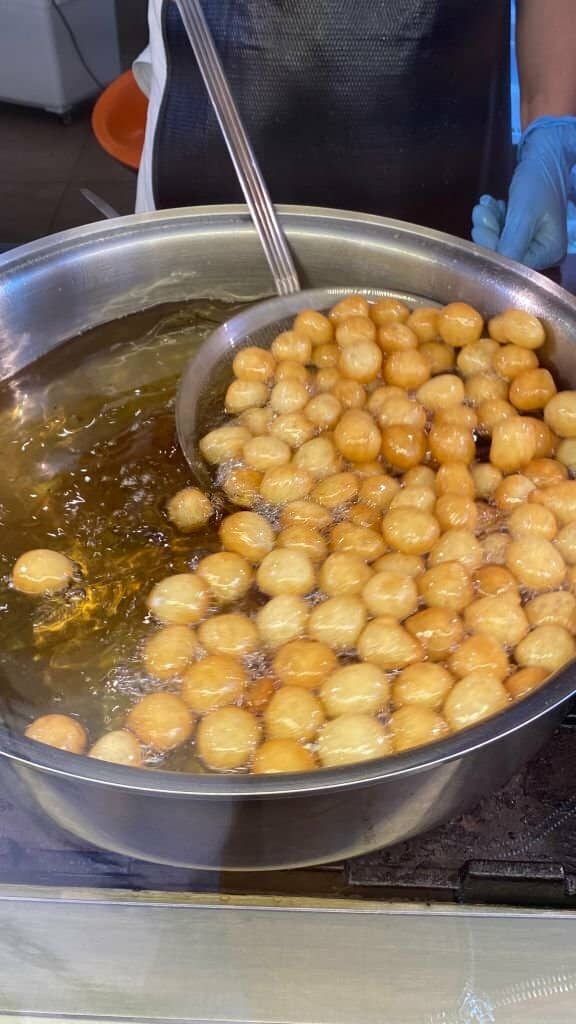Lokma is a Middle Eastern dessert made with fried dough balls soaked in syrup or honey and topped with cinnamon or other spices. It is often enjoyed as a dessert or snack throughout the Middle East and Mediterranean countries.
People have enjoyed this dessert since as far back as the 13th century by al-Baghdadi as luqmat al-qādi, “judge’s morsels”. If you want to know more about this delightful dessert, read our post to more including origin, variety, preparation, serving, and more.
What is Lokma

Lokma is a delicious Turkish sweet made with dough balls fried to golden brown and then soaked in syrup or honey and topped with cinnamon. It is a little crispy on the outside and soft, and spongy on the inside.
Lokma has its roots in the early medieval era during the Abbasid caliphate of the 13th century. It appeared in various cookbooks from that time.
Lokma is called luqma in Arabic which means bite, morsel, or mouthful. In the 13th century, it was called Luqmat al-Qadi, “judge’s morsels”. In Turkish it is called lokma and in Greek “loukoumádes”, both words come from Arabic.
Although it is known by different names in different regions the preparation and the are almost the same.
History of Lokma
Lokma or Luqmat al-Qadi is a delightful dessert that originated from Iraq. The origins of Lokma are tracked to the early medieval period and the 13th-century Abbasid Caliphate where it was mentioned in various cookbooks of that time. It also appears in One Thousand and One Nights, specifically in the tale of The Porter and the Three Ladies of Baghdad.
According to Turkish tradition, family and friends prepare lokma and offer it to neighbors and passersby 40 days after a person dies. They line up to receive them and recite a prayer in honor of the soul of the deceased.
Lokma was prepared for centuries by Palace cooks of the Ottoman Empire. They were inspired by the Balkans, the Middle East, and the Caucasus.
Variety of Lokma Dessert

There are various types of Lookma present in different regions. even though they know differently the taste and the preparation are almost the same.
Turkey Lokma
In Turkey, there are different types of lokma are present. It is made with flour, sugar, and yeast, fried to golden, and drenched in sugar or honey. They also eat it with topped cream. Izmir Lokmasi is a doughnut-shaped lokma made with a hole in the middle.
According to Turkish tradition, Lokma was prepared after 40 days of the death of a person and served to neighbors and passersby. They line up to receive them and recite a prayer in honor of the soul of the deceased.
Arab Lokma
Lokma is known as luqaymat in Arab countries. In the Arab countries of the Persian Gulf, luqaymat remains quite similar to recipes from the 13th century.
Sometimes flavored with cardamom or saffron their size and taste vary throughout the country.
In some parts, Lokam is known as awameh which means “swimmer,” or zalabya with different spellings.
Cyprus Lokma
These pastries are known as loukoumádes in Cypriot Greek. They are often served with cinnamon in a sweet honey syrup and dusted with a bit of powdered sugar.
Greece Lokma
Loukoumades are a popular Greek dish, especially in southern Greece they are often enjoyed as street food.
In ancient Greek literature, they were known as “honey tokens” and were given as small gifts to winners of the Olympic games.
In Byzantine times, they were likely called spongoi or sfongoi which derived from the Greek word for the sponge.
The Romaniotes, Greek Jews, referred to them as zvingoi and made them as treats for Hanukkah. Pontic Greeks, who migrated from the Black Sea call them tsirichta and serve them at weddings.
Lokma Vs Gulab Jamun
Lokma and Gulab Jamun are both different desserts with different tastes and origins however, they look similar.
Gulab Jamun is an Indian delicacy that consists of fried dough soaked in sugar syrup and often sprinkled with saffron while Lokma is an Arabic dessert.
Gulab jamun is a soft gooey dessert. Although the preparation looks very similar they are very different in taste. Both have their culinary significance.
How to Make Lokma Dessert

This dessert is super easy to make with ingredients you probably already have in your pantry.
Firstly, prepare a dough with flour, yeast or yogurt, saffron, cardamom, and a hint of rose water, or orange blossom water.
After preparing the dough, fry it until golden and leave for a few minutes.
Then warm Lokma soaked in a sugar syrup or honey and finally topped with nuts, saffron, or sugar powder.
Ingredients
For the Dough:
- 2 cups all-purpose flour
- 1 teaspoon active dry yeast
- 1 cup lukewarm water
- 1/2 teaspoon salt
- 1 teaspoon sugar
For the Syrup:
- 1 cup sugar
- 1/2 cup water
- 1 tablespoon lemon juice
For Frying:
- Vegetable oil
Instructions
Prepare the Dough:
- In a small bowl, mix the lukewarm water, sugar, and yeast. Allow it to sit for about 5-10 minutes until it becomes frothy.
- In a large mixing bowl, combine the flour and salt. Make a well in the center and pour in the yeast mixture.
- Mix the ingredients until a sticky dough forms.
- Cover the bowl with a kitchen towel and let the dough rise for 1-2 hours, or until it doubles in size.
Make the Syrup:
- While the dough is rising, prepare the syrup. In a saucepan, combine sugar, water, and lemon juice.
- Bring the mixture to a boil, then reduce the heat and simmer for about 5-7 minutes until it slightly thickens. Remove from heat and let it cool.
Fry the Lokma:
- Heat vegetable oil in a deep fryer or a deep, heavy-bottomed pan to 350°F (175°C).
- Wet your hands with water to prevent the dough from sticking. Take small portions of the dough with your fingers and drop them into the hot oil.
- You can use a spoon to shape them or simply tear off small pieces of dough.
- Fry until the lokma turns golden brown, turning them occasionally to ensure even cooking. This usually takes 2-3 minutes per batch.
- Using a slotted spoon, remove the fried lokma and place them on a plate lined with paper towels to absorb excess oil.
Coat with Syrup:
- While the lokma are still warm, immerse them in the prepared syrup, making sure they are well-coated. You can use a fork or a slotted spoon for this step.
- Allow the lokma to soak in the syrup for a minute or two, ensuring they absorb the sweet flavor.
Serve:
- Arrange the lokma on a serving platter and drizzle any remaining syrup over the top.
- Optionally, you can sprinkle chopped nuts like walnuts or pistachios over the lokma for added flavor and texture.
Enjoy your homemade lokma!
Tips for Making Lokma
- Ensure that your yeast is active and not expired.
- Knead the dough well to achieve a smooth and elastic texture.
- Heat the oil to the right temperature (around 350°F or 175°C) to ensure that the Lokma cooks evenly and becomes golden brown.
- Maintain consistency in the size of the Lokma for even cooking.
- Use a spoon or an ice cream scoop to shape and drop uniform-sized portions into the hot oil.
- Prepare a sugar syrup with the desired level of sweetness.
- Allow the Lokma to absorb the syrup for a few minutes before serving.
- Lokma is best enjoyed fresh so try to serve them soon after preparation.
- If you need to store them, keep them in an airtight container, but note that they might lose their crispiness over time.
How to Serve Lokma
You can serve it many different ways but for the best experience but I would advise you to serve it on a dessert plate. Gently place these golden bite-sized delights on a plate.
Sprinkle powdered sugar on top, pistachio, or any other nuts. Don’t forget to offer some hot tea or coffee to elevate the experience.
You can serve them after a meal, as a snack, or as a starter as they are bite-sized desserts so it is very convenient to eat them safely in a bite.
Related Post:
All About Basbousa Arabic Dessert
28 Arabic Sweets Names With Pictures
Summary
Lokma is a tasty dessert from the Middle East that goes back to the 13th century. People in Turkey, the Arab world, Cyprus, and Greece love it.
Lokma has different flavors and ways to make it which shows how diverse the recipes are from various culinary traditions.
People enjoy Lokma after meals, as a snack, or during special events. It’s crispy outside and soft on the inside.
You can easily make Lokma with some simple tips.
Ingredients
- For the Dough:
2 cups all-purpose flour
1 teaspoon active dry yeast
1 cup lukewarm water
1/2 teaspoon salt
1 teaspoon sugar
- For the Syrup:
1 cup sugar
1/2 cup water
1 tablespoon lemon juice
Directions
- In a small bowl, mix the lukewarm water, sugar, and yeast. Allow it to sit for about 5-10 minutes until it becomes frothy.
- In a large mixing bowl, combine the flour and salt. Make a well in the center and pour in the yeast mixture.
- Mix the ingredients until a sticky dough forms.
- Cover the bowl with a kitchen towel and let the dough rise for 1-2 hours, or until it doubles in size.
- While the dough is rising, prepare the syrup. In a saucepan, combine sugar, water, and lemon juice.
- Bring the mixture to a boil, then reduce the heat and simmer for about 5-7 minutes until it slightly thickens. Remove from heat and let it cool.
- Heat vegetable oil in a deep fryer or a deep, heavy-bottomed pan to 350°F (175°C).
- Wet your hands with water to prevent the dough from sticking. Take small portions of the dough with your fingers and drop them into the hot oil.
- You can use a spoon to shape them or simply tear off small pieces of dough.
- Fry until the lokma turns golden brown, turning them occasionally to ensure even cooking. This usually takes 2-3 minutes per batch.
- Using a slotted spoon, remove the fried lokma and place them on a plate lined with paper towels to absorb excess oil.
- While the lokma are still warm, immerse them in the prepared syrup, making sure they are well-coated. You can use a fork or a slotted spoon for this step.
- Allow the lokma to soak in the syrup for a minute or two, ensuring they absorb the sweet flavor.
- Arrange the lokma on a serving platter and drizzle any remaining syrup over the top.
- Optionally, you can sprinkle chopped nuts like walnuts or pistachios over the lokma for added flavor and texture.

